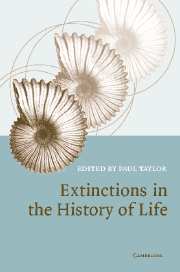Book contents
- Frontmatter
- Contents
- Notes on contributors
- Preface
- 1 Extinction and the fossil record
- 2 Extinctions in life's earliest history
- 3 Mass extinctions in plant evolution
- 4 The beginning of the Mesozoic: 70 million years of environmental stress and extinction
- 5 Causes of mass extinctions
- 6 The evolutionary role of mass extinctions: disaster, recovery and something in-between
- Glossary
- Index
- References
4 - The beginning of the Mesozoic: 70 million years of environmental stress and extinction
Published online by Cambridge University Press: 18 December 2009
- Frontmatter
- Contents
- Notes on contributors
- Preface
- 1 Extinction and the fossil record
- 2 Extinctions in life's earliest history
- 3 Mass extinctions in plant evolution
- 4 The beginning of the Mesozoic: 70 million years of environmental stress and extinction
- 5 Causes of mass extinctions
- 6 The evolutionary role of mass extinctions: disaster, recovery and something in-between
- Glossary
- Index
- References
Summary
INTRODUCTION
Coral reefs are one of Earth's environments where a visitor experiences sensory overload. A snorkeler or diver in a tropical shallow sea is commonly overwhelmed with a dazzling array of colourful fish and invertebrate animals, including corals of all shapes and sizes (Figure 4.1). Corals are colonial animals and the many polyps of the colony build large common skeletons made of calcium carbonate that typically constitute the main physical structure of modern reefs. Lurking in the nooks and crannies of coral reefs are a great variety of animals with fascinating morphologies and life habits (Figure 4.1). It is no wonder that coral reefs are such a popular destination for human recreation.
The fascination of coral reefs is not only for the casual observer, but also for scientists interested in the numbers of animals on Earth and general issues of biodiversity. Coral reefs are found along one-sixth of the world's coastlines (Birkeland, 1997), and are the most biologically diverse of nearshore ecosystems (Roberts et al., 2002). They are an integral part of the natural landscape on Earth today, and yet they are one of the ecosystems that has been most severely affected by global warming and human activities. Thus, much like tropical rain forests, coral reefs are considered to be fragile environments that we are in danger of losing due largely to our own activities. It is hard for anyone to imagine a world without coral reefs.
- Type
- Chapter
- Information
- Extinctions in the History of Life , pp. 99 - 118Publisher: Cambridge University PressPrint publication year: 2004
References
- 3
- Cited by



